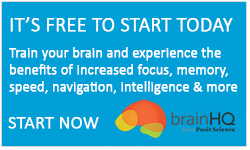The following Q&A was prepared by Posit Science.
- What is Chemobrain (or Cancer-Related Cognitive Decline)?
In the 1980s, breast cancer survivor support groups began to draw attention to different types of cognitive impairment, as an adverse effect of chemotherapy that persisted even after the cancer treatment ended.
Initially, this condition was called “chemobrain” or “chemofog.” At first, there was widespread doubt in the medical community about the condition. In the 1990s, the condition began to be studied. The condition is now often referred to as “cancer-related” or “cancer-induced” “cognitive decline” or “cognitive impairment.” We use the term “cancer-related cognitive decline.”
- What causes Cancer-Related Cognitive Decline?
There is disagreement among experts as to its cause (or causes), which have been said to include the cancer itself, the treatment of the cancer, stress related to the patient’s condition, and inflammatory dysfunction. There is a growing consensus that the condition may arise from multiple causes.
- How prevalent, persistent, and severe is Cancer-Related Cognitive Decline?
Estimates vary from 10 to 40 percent of cancer survivors overall, and up to 70 percent of patients treated with chemotherapy.
Research indicates that symptoms can persist for 10 or more years. Effects (as with other forms of cognitive impairment) can interfere with maintaining employment, relationships, and day-to-day independence.
Millions of patients receive chemotherapy each year, and , globally, there are more than 35 million people with greater than five years of cancer survivorship. This suggests 3.5 million to 14 million people, globally, may experience cancer-related cognitive decline.
- How is Cancer-Related Cognitive Decline treated?
Generally it isn’t. Patients are sometimes suggested compensatory strategies, such as using calendars or making lists. There are no broadly accepted (or FDA-approved) interventions for cancer-related cognitive decline.
- What is the design of this study?
The study was designed as a pragmatic, longitudinal, randomized controlled trial.
“Pragmatic” trials are designed to evaluate the effectiveness of interventions in “real-world” conditions. Here, the trial was designed to reach patients at home, using assessments and training that could be performed without direct supervision.
The study participants were randomized into a control group and an intervention group. Before randomization, all subjects participated in a 30-minute structured telephone consultation outlining cognitive compensatory strategies for cognitive decline. The control group (of 121 participants) received standard care from their health care professionals. The intervention group (of 121 participants) also received standard care, and each group member was asked to complete 40 hours of brain exercises over the course of 15 weeks (at 40 minutes per session, 4 times per week).
Each participant was measured on a primary and a number of secondary outcome measures (see below) at the beginning of the study, after 15 weeks, and six months later.
- Who participated in this study?
The researchers recruited adult cancer survivors, through 18 Australian sites, who had been treated for a primary (non-CNS) malignancy, who had completed at least three cycles of adjuvant chemotherapy in the prior 6-60 months, and who reported persistent cognitive symptoms. Participants were required to be fluent in English and to have access to a computer and the internet. Of the participants, 95% were female. On average, it had been 27 months since their completion of chemotherapy, and their average age was 53 (with an age range of 23 to 74). Some 89% had breast cancer, 5% had colorectal cancer, and the balance was distributed across other cancers.
- Who ran and paid for this study?
Researchers from the Survivorship Research Group, University of Sydney, Australia organized and reported on this study. The study authors are:
Victoria J. Bray, University of Sydney; Liverpool Hospital–first author
Haryana M. Dhillon, University of Sydney
Melanie L. Bell, University of Sydney; University of Arizona
Michael Kabourakis, University of Sydney
Mallorie H. Fiero, University of Arizona
Desmond Yip, Australian National University
Frances Boyle, University of Sydney; Patricia Ritchie Centre for Cancer Care and Research
Melanie A. Price, University of Sydney
Janette L. Vardy, University of Sydney – senior authorGrant funding and support was provided by: Cancer Council New South Wales, Friends of the Mater Foundation, a Cancer Institute New South Wales Clinical Fellowship (V.J.Bray), a Clinical Oncology Society of Australia / Roche Hematology Oncology Targeted Therapies Fellowship (V.J.Bray .), a Pfizer Cancer Research Grant (V.J.Bray), and by the National Breast Cancer Foundation (J.L. Vardy).
- What did the study show?
The study had many outcome measures, as discussed below.
The primary question of the study was whether use of these specific brain exercises would lessen a patient’s experience of negative cognitive symptoms. The exercises had that effect.
- What was the primary outcome of this study?
The primary outcome measure for this study was self-reported cognitive function, as assessed by the FACT-COG questionnaire, Perceived Cognitive Impairment (PCI) subscale. The primary outcome score was the FACT-COG PCI score, as measured immediately after training.
Researchers reported that the intervention group, as compared to the control group, reported significantly better performance on the Perceived Cognitive Impairment measure (the primary outcome measure: FACT-COG PCI) immediately after the intervention (p<0.0001), and six months later (p<0.0002).
- What are the secondary outcomes of this study?
The study established a number of secondary outcome measures. The main secondary outcome measure was neuropsychological function, as assessed by Cogstate (an 18-minute computerized battery that can be downloaded and self-administered, at home). The other secondary outcome measures were widely used and validated self-assessment questionnaires, including: anxiety & depression (12-item General Health Questionnaire), quality of life (FACT-General), fatigue (FACT -Fatigue subscale), and stress (14-item Perceived Stress Scale). The other (non-PCI) subscales of the FACT-COG were also used as secondary measure.
Because of the multiple secondary measures explored, the secondary measures were held to a more conservative 99% confidence interval for significance, rather than the 95% confidence interval normally used. The computerized neuropsychological assessment (Cogstate) showed no between group difference after training or six months later.
The intervention group had significantly better performance on most of the secondary measures, including on the stress measure after intervention and at six months; on the fatigue and anxiety/depression measures after training and with a trend to better performance at six months; on the quality of life measure at six months, but not immediately after training; and on all FACT-COG subscales after intervention, but only on some at six months.
- What were the brain exercises used in this study?
The intervention group used five visual speed of processing exercises distributed by Posit Science, and commercially available as part of the BrainHQ online and app brain fitness subscription service. The exercises that were utilized appear on BrainHQ as:
Double Decision
Hawk Eye
Visual Sweeps
Eye for Detail
Target TrackerThese exercises represent BrainHQ’s core visual processing suite of exercises, targeting visual speed and accuracy (previously marketed as the InSight suite, and including Double Decision, which is often referred to in the scientific literature as “UFOV® training” or “speed training”).
More specifically, these exercises target visual processing speed, focus, suppression, selective attention, divided attention, working memory, accuracy, acuity, search, useful field of view, peripheral and core attention, direction, and multiple object tracking.
- What were usage levels for the exercises in the study?
The patients in the intervention group were asked to complete 40 hours of training. Usage levels of the brain exercises varied by patient, with an average usage of 25.08 hours (and a range of 0.19 to 55.82 hours) in the “intent to treat” group. Some 14% of patients assigned to training never started it, and the remaining 86% did just over 34 hours of training, on average.
- What are the authors’ conclusions?
The authors conclude: “Previous research has shown cognitive rehabilitation strategies to be feasible, with preliminary evidence of efficacy. Our large RCT [randomized controlled trial] adds weight to this evidence, confirming that the use of Insight [the visual speed exercises] led to an improvement in cognitive symptoms. Importantly, there were also improvements in PRO [patient-reported outcomes], including QOL [quality of life] and reduction in stress, fatigue, and anxiety/depression. The program has the additional advantages of being relatively nexpensive and home based, allowing individuals to direct their own treatment. The program has the potential to provide a new treatment option for patients with cancer with cognitive symptoms, where previously none existed.“[emphasis added]
- How does this fit with the prior literature?
This study extends work reported in 2012 in the paper “Advanced cognitive training for breast cancer survivors: a randomized controlled trial” published in the journal Breast Cancer Research Treatment. The lead author of that prior paper was Dr. Diane Von Ah, and we refer to that prior study below as the “Von Ah study.”
The Von Ah study looked at 82 breast cancer survivors, randomized into three arms. The first intervention arm used the same five visual speed of processing exercises from BrainHQ used in the new study; the second intervention arm used a memory training program that taught strategies for remembering; and a third arm was a wait-list control. Each intervention was administered to groups in 10 one-hour sessions, completed over 6-8 weeks.
The primary outcome assessments were professionally-administered, objective europsychological tests of memory and speed of processing. There were a number of secondary outcome measures, including: perceived cognitive function, symptom distress (mood, anxiety, fatigue) quality of life, and intervention satisfaction. Data were collected at baseline, after intervention and at a 2-month follow-up.
Von Ah and colleagues found that both interventions significantly improved the domain-related objective cognitive performance (ie, the memory training group got significantly better at memory tests than the control, and the visual speed training group got significantly better at the speed test than the control). However, the speed training group showed transfer to memory, with significant effects in memory, after training and at the 2-month follow-up, that were larger than the memory group. Both interventions had significant effects on most secondary measures at both time points, and were found satisfactory by users.
The Von Ah study results led to a new clinical guideline from the Oncological Nursing Society recommending this kind of brain training in a group setting (https://www.ons.org/practice-resources/pep/cognitive-impairment). The new study extends these results, by moving to a pragmatic trial, in which patients are asked to make use of the BrainHQ intervention on their own, at home. This reflects a much less expensive, and much more scalable, mode of distribution and administration.






 English
English
 Français
Français


